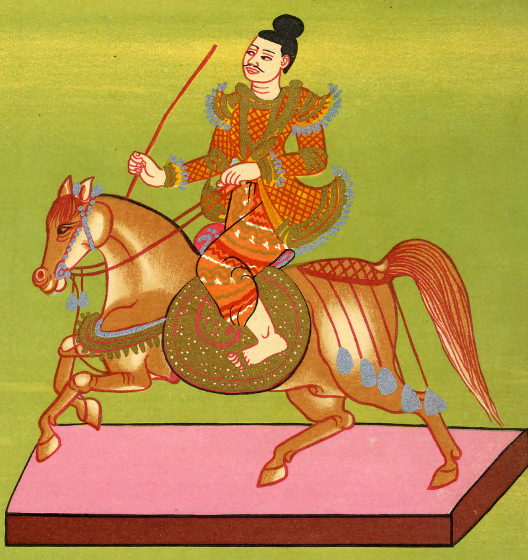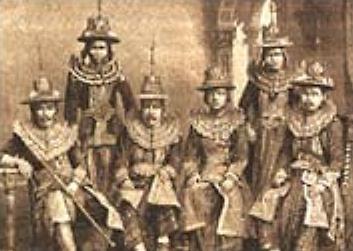|
Minyekyawswa
Minye Kyawswa (, ; also Minyekyawswa and Minrekyawswa; January 1391 – 13 March 1415) was crown prince of Ava from 1406 to 1415, and commander-in-chief of Ava's military from 1410 to 1415. He is best remembered in Burmese history as the courageous general who waged the fiercest battles of the Forty Years' War (1385–1424) against King Razadarit of Hanthawaddy Pegu. The prince was his father King Minkhaung I's best and most trusted general. Between 1406 and 1415, the father and son team waged war on all of Ava's neighbors, and nearly succeeded in reassembling the Pagan Empire under Ava's leadership. On the cusp of final victory, he was wounded in a battle near Twante–Dala, and captured in March 1415. The crown prince of Ava refused treatment, and died shortly after. He was 24. Minkhaung and Minye Kyawswa's struggles against Razadarit are retold as classic stories of legend in Burmese popular culture. Minye Kyawswa's name is still invoked alongside the names of greate ... [...More Info...] [...Related Items...] OR: [Wikipedia] [Google] [Baidu] |
Maung Minbyu
Maung Minbyu ( ) is one of 37 nat (spirit), nats (spirits) in the official Burmese pantheon of nats. Maung Minbyu is identified with several historical figures. One version suggests he was an unnamed prince of Ava who married the daughter of a cavalry commander. He died from overuse of opium. In another version, he was the reincarnation of Bawlawkyantaw, the son of Razadarit, the king of Hanthawaddy, who was executed by his father when he was only about seven years old. He is also identified with the Crown Prince Minye Kyawswa, and son of Minkhaung I of Ava Kingdom. The fiery prince, whose birth name was Min Phyu (or Minbyu), died of wounds in the Forty Years' War in March 1415. References {{Burmese nats Burmese nats, *23 Deified Burmese people ... [...More Info...] [...Related Items...] OR: [Wikipedia] [Google] [Baidu] |
Min Kyawzwa
Min Kyawzwa (, ; also known as U Min Gyaw and Ko Gyi Kyaw), is one of the 37 nats in the official pantheon of Burmese nats. He is a composite representation of multiple historical personalities. One version puts him as a son of King Theinhko of Pagan; he was murdered by his brother. Another version puts him as an adviser to King Alaungsithu of Pagan; he died an alcoholic. Another puts him as Crown Prince Minye Kyawswa of Ava, who fell in action in the Forty Years' War. Yet another version puts him as a son of the Lord of Pyay and Kuni Devi. He reportedly was a "drunkard and cock fighter and also a good rider", killed by his victims turned devils. Ma Ngwe Taung, another nat, was seduced by Min Kyawzwa when they were both humans and abandoned by him. She pined for him so much that her brother, who did not approve of Min Kyawzwa, became angry and pushed her off a cliff. She helps women abandoned by husbands or lovers. Min Kyawzwa is the guardian of drunkards and gamblers, and gr ... [...More Info...] [...Related Items...] OR: [Wikipedia] [Google] [Baidu] |
Razadarit
Razadarit (, ; , or ; also spelled Yazadarit, "king of kings"; 1368–1421) was king of Kingdom of Hanthawaddy, Hanthawaddy Pegu from 1384 to 1421. He successfully unified his Mon language, Mon-speaking kingdom, and fended off major assaults by the Burmese language, Burmese-speaking Kingdom of Ava, Ava Kingdom (Inwa) in the Forty Years' War. The king also instituted an administrative system that left his successors with a far more integrated kingdom. He is one of the most famous List of Burmese monarchs, kings in Burmese history. Razadarit came to power at 16 after a rebellion against his father King Binnya U (r. 1348–1384), barely controlling the Pegu province. By his sheer will and military leadership, the young king not only defeated Ava's Ava–Hanthawaddy War (1385–1391), first wave of invasions (1385–1391) but also unified his kingdom in the process. After presiding over Pegu's emergence as a regional power, he twice renewed the war with Ava in the 1400s, and outla ... [...More Info...] [...Related Items...] OR: [Wikipedia] [Google] [Baidu] |
Forty Years' War
The Forty Years' War (; 1385 – 1423; also Ava–Pegu War or the Mon–Burmese War) was a military war fought between the Burmese-speaking Kingdom of Ava and the Mon-speaking Kingdom of Hanthawaddy. The war was fought during two separate periods: 1385 to 1391, and 1401 to 1424, interrupted by two truces of 1391–1401 and 1403–1408. It was fought primarily in today's Lower Burma and also in Upper Burma, Shan State, and Rakhine State. It ended in a stalemate, preserving the independence of Hanthawaddy, and effectively ending Ava's efforts to rebuild the erstwhile Pagan Kingdom. First half The war's origins can be traced to Hanthawaddy Pegu's political turmoil, which intensified after King Razadarit's rise to power in 1384 through a rebellion against his ailing father. Governor Smin Sam Lek of Donwun and Viceroys Laukpya of Myaungmya and Byattaba of Martaban refused to recognize the new king. Laukpya would invite King Swa Saw Ke of the Ava Kingdom to ... [...More Info...] [...Related Items...] OR: [Wikipedia] [Google] [Baidu] |
Burmese History
The history of Myanmar ( ) covers the period from the time of first-known human settlements 13,000 years ago to the present day. The earliest inhabitants of recorded history were a Tibeto-Burman-speaking people who established the Pyu city-states ranged as far south as Pyay and adopted Theravada Buddhism. Another group, the Bamar people, entered the upper Irrawaddy valley in the early 9th century. They went on to establish the Pagan Kingdom (1044–1297), the first-ever unification of the Irrawaddy valley and its periphery. The Burmese language and culture slowly came to replace Pyu norms during this period. After the First Mongol invasion of Burma in 1287, several small kingdoms, of which the Kingdom of Ava, the Hanthawaddy Kingdom, the Kingdom of Mrauk U and the Shan States were principal powers, came to dominate the landscape, replete with ever-shifting alliances and constant wars. From this time, the history of this region has been characterised by geopolitical struggles ... [...More Info...] [...Related Items...] OR: [Wikipedia] [Google] [Baidu] |
Royal Burmese Armed Forces
The Royal Armed Forces (,See (Maha Yazawin 2006: 26), (Yazawin Thit Vol. 1 2012: 236), (Hmannan Vol. 2 2012: 2) for example. ) were the armed forces of the History of Myanmar, Burmese monarchy from the 9th to 19th centuries. It refers to the military forces of the Pagan Kingdom, the Kingdom of Ava, the Hanthawaddy Kingdom, the Toungoo dynasty and the Konbaung dynasty in chronological order. The army was one of the major armed forces of Southeast Asia until it was defeated by the British Empire, British over a six-decade span in the 19th century. The army was organised into a small standing army of a few thousand, which defended the capital and the palace, and a much larger conscription, conscript-based wartime army. Conscription was based on the ''ahmudan'' system, which required local chiefs to supply their predetermined quota of men from their jurisdiction on the basis of population in times of war. The wartime army also consisted of war elephant, elephantry, cavalry, artill ... [...More Info...] [...Related Items...] OR: [Wikipedia] [Google] [Baidu] |
Crown Prince
A crown prince or hereditary prince is the heir apparent to the throne in a royal or imperial monarchy. The female form of the title, crown princess, is held by a woman who is heir apparent or is married to the heir apparent. ''Crown prince'' as a descriptive term has been used throughout history for the prince who is first-in-line to a throne and is expected to succeed (i.e. the heir apparent), barring any unforeseen future event preventing this. In certain monarchies, a more specific substantive title may be accorded and become associated with the position of heir apparent (e.g. Prince of Wales in the United Kingdom, Prince of Asturias in the Spain, Kingdom of Spain and formerly the Dauphin of France, Dauphin in Kingdom of France, France). In these monarchies, the term crown prince may be used less often than the substantive title (or never). Until the late twentieth century, no modern monarchy adopted a system whereby females would be guaranteed to succeed to the throne ... [...More Info...] [...Related Items...] OR: [Wikipedia] [Google] [Baidu] |





